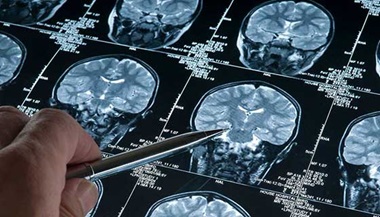Brain Tumors: Radiation Therapy
Radiation therapy uses strong beams of energy to kill brain cancer cells. It helps control the growth of some types of brain tumors. It’s often used along with surgery or chemotherapy to treat brain tumors.
When might radiation therapy be used to treat a brain tumor?
Radiation therapy may be used to treat a brain tumor:
- After surgery (sometimes with chemotherapy) to try to kill tumor cells left in the brain
- As the main (primary) treatment if surgery can’t be done
- To help relieve symptoms caused by the tumor
Types of Radiation Therapy for Brain Tumors
There are 2 main types of therapy. You may get both types. They include:
- External beam radiation therapy (EBRT). For this type, a machine sends the rays of energy to the tumor. This treatment is usually done every weekday over several weeks.
- Internal radiation (brachytherapy). This is also called interstitial therapy. Small seeds of radiation are put inside or near the tumor.
External beam radiation therapy (EBRT)
There are several types of EBRT. The goal is to target the tumor and limit damage to nearby healthy brain cells. To limit the harm, your healthcare provider may use special types of EBRT such as:
- 3-D conformal therapy (3D-CRT). For this treatment, a computer uses imaging scans to match the radiation beams to the shape of the tumor from different angles. These may be CT or MRI scans.
- Intensity modulated radiation therapy (IMRT). This is a lot like 3D-CRT. It lets the healthcare provider control the intensity or strength of the radiation beams pointed at different parts of the tumor.
- Conformal proton beam therapy. This is like IMRT. But it uses energy beams of charged particles called protons instead of X-rays. Protons stop more quickly than X-rays after hitting a target. This may lead to less damage to the tissues the beams pass through to reach the tumor.
- Stereotactic radiosurgery (SRS). This method can be used on small tumors. Though it's called surgery, there's no cutting. A high-energy dose of radiation is sent to the tumor from many angles. It may be given as a single dose. Or it may be given as several doses over a few days. There are 2 main types of SRS:
- Gamma knife radiation. This uses radiation beams called gamma rays. The rays are sent from a machine and focused at the tumor from hundreds of angles at the same time. Treatment is usually done in 1 session.
- Linear accelerator based. Instead of sending many beams at once, this machine moves around the head to send radiation to the tumor from different angles. Treatment is usually done in 1 to 5 sessions.
Imaging tests will be done to see if the cancer has spread to other parts of your brain or spinal cord. If the cancer has spread, you may have radiation to your whole brain and spinal cord.
Brachytherapy
For this treatment, the radiation is placed very close to or inside the tumor. This is done during surgery. The radiation the implants give off travels a very short distance. This helps limit the effect on nearby healthy tissue.
Liquid Radiation After Brain Tumor Surgery
Another radiation treatment is the GliaSite radiation therapy system (RTS) developed at Johns Hopkins. It delivers radiation from within the hole created by the surgical removal of a malignant brain tumor. GliaSite RTS is used for newly diagnosed, metastatic and recurrent brain tumors.
A few days after surgical removal of the tumor, liquid radiation is delivered to the edges of the tumor hole through a catheter (a thin, hollow tube). The liquid radiation targets places in and around the tumor site where cancer cells may remain. It delivers a precise amount of radiation for a few days. Then the catheter is removed.
Brain Radiation Side Effects
Generally, side effects from radiation treatment are grouped into two categories:
- Short-term side effects, which occur within six weeks of treatment
- Delayed side effects, which are rarer than short-term effects and can start months or even years later
Short-term side effects of brain tumor radiation include:
- Fatigue
- Appetite loss
- Hair loss
- Headaches
- Nausea
Long-term side effects include:
- Common:
- Mild memory or confusion
- Cataracts
- Uncommon:
- Hearing difficulty
- Loss of function specific to area treated: vision, language, motor or sensory
- Rare:
- New tumors in scalp, skull or brain
- Vascular issues, including stroke
The risk for these side effects depends on your age, the radiation dose used and the size of the area treated, and the location. Some tumors can be treated with focal radiation, which targets a smaller area than whole brain radiation. Larger treatment areas are generally associated with greater risk of long-term effects.
Radiation necrosis
Sometimes dead brain tissue forms at the site of the radiation. This is called radiation necrosis. The mass of dead brain tissue comes from both cancer cells and healthy cells. Radiation necrosis can take anywhere from months to years to develop.
Radiation necrosis may need to be removed with surgery if it causes problems like headaches and seizures.
It's not always easy to tell the difference between radiation necrosis and cancer that has come back. A brain scan can sometimes tell the difference. But often a biopsy is the only way to tell for sure.
Radiation necrosis is less common these days. This is because detailed imaging tests and newer ways to precisely aim radiation at a tumor are now used.
Risk of future cancer
Radiation can damage the DNA in healthy cells. As a result, you have a small risk of a second brain cancer after brain radiation. This second cancer usually occurs many years later. Talk to your radiation oncologist about the risks and benefits of radiation therapy.
The Radiation Team
Treatment planning for radiation therapy includes mapping to pinpoint the exact location of the brain tumor using X-rays or other images.
A radiation oncologist uses these images to create a 3D picture of your brain. For some types of radiation therapy, a custom-fitted mask is created to increase the precision of the treatment. Fiducials — small markers temporarily attached to the scalp — may also be used.
A radiation oncologist then designs your treatment, determining the most appropriate radiation dose (the level of radiation energy to be used) and delivery method.
A dosimetrist or medical physicist (professionals who specialize in using radiation therapy equipment and calculating and measuring radiation) will calculate the dose, the angle of the treatment beam and the amount of time for each beam. After they work with the radiation oncologist to review the calculations, the treatments can be scheduled.





